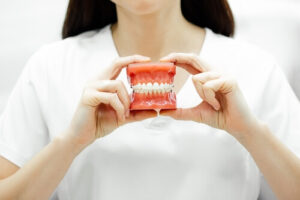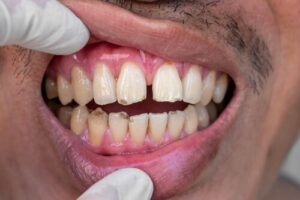If you’re exploring how to fill the gap between teeth and gums naturally, you’re not alone. Many individuals seek ways to address these gaps that can appear due to various dental issues. While the concept of naturally narrowing these spaces might seem challenging, there are proactive steps to take to improve your dental health and aesthetics.
This article will explore several natural approaches to help you see a difference. Stay tuned as we explore these gentle yet effective methods to improve the appearance of your smile and boost your oral health.
Introduction to Natural Remedies for Dental Gaps

Exploring natural remedies to address gaps between teeth is a growing interest for those looking to improve their dental aesthetics and oral health without invasive procedures. These gaps in front teeth, often caused by gum recession or tooth movement, can be managed through various non-surgical methods.
Good oral hygiene is foundational: Regular brushing and flossing remove food particles and plaque that can lead to gum disease, which might exacerbate gap issues.
Oil Pulling: This ancient practice, known as oil pulling, implies swishing coconut or sesame oil in your mouth. It’s believed to pull toxins from the gums and teeth, potentially helping to tighten the gum tissue and close small gaps.
Aloe Vera Gel: This remedy possesses anti-inflammatory properties; applying aloe vera gel to the gums may help soothe inflammation and promote healthy gum tissue, indirectly affecting the stability of teeth and gaps.
Green Tea: Consuming green tea regularly can support oral health due to its anti-inflammatory and antioxidant properties, which may prevent further gum recession and protect against periodontal diseases.
Essential Oils: Some essential oils, including eucalyptus and peppermint, have antibacterial properties that can benefit gum health. Diluted and applied to the gums, they may reduce inflammation and support oral hygiene.
Proper Nutrition: Diet plays an important role in oral health. Foods rich in vitamins like vitamins C and D, calcium, and omega-3 fatty acids support gum health, which is essential for maintaining tight, healthy gaps between teeth and gums.
Understanding the Causes of Gaps Between Teeth and Gums
Identifying the underlying causes of gaps between teeth and gums is crucial for implementing effective treatments and ensuring long-term oral health. These gaps in teeth, often more than cosmetic issues, can indicate deeper health concerns.
Gum Recession
One primary reason for gaps is gum recession, where the gum tissue pulls back from the tooth, exposing more of the tooth or its root. Gum recession can be a consequence of periodontal disease, aggressive brushing, or genetics.
Periodontal Diseases
Periodontal disease is a serious gum infection that tears the soft tissue and, if untreated, can destroy the bone that supports teeth. It can cause teeth to become loose and create noticeable gaps.
Tooth Movement
Teeth can shift due to insufficient dental care, loss of adjacent teeth, or pressure from habits like thumb sucking or incorrect swallowing (tongue thrusting). This movement can create gaps between the teeth and between the teeth and gums.
Bone Loss
Underlying jaw and teeth bone health issues, often related to osteoporosis or other systemic conditions, can lead to changes in the dental structure and gaps.
Age-Related Changes
As people age, natural changes in the mouth can lead teeth to shift. This gradual shifting can result in gaps that weren’t previously noticeable.
Genetic Predisposition
In some cases, the natural spacing and alignment of teeth are determined by genetics, leading to gaps from an early age that might widen with time.
Daily Oral Hygiene Practices to Minimize Gaps

Maintaining stringent daily oral hygiene practices is key to the teeth naturally minimizing gaps between teeth and gums, safeguarding against the progression of oral health issues that can exacerbate these gaps.
Regular Brushing and Dental Floss
Committing to twice-daily brushing and daily flossing is essential. This routine removes food particles and plaque that can lead to gum disease, a common cause of gum recession and subsequent gaps.
Use of the Right Tools
Employing a soft-bristled toothbrush and non-abrasive toothpaste can prevent damage to both gum tissue and tooth enamel. Gentle brushing techniques should be emphasized to avoid pushing the gums away from the teeth, which can widen gaps.
Antimicrobial Mouthwash
Integrating an antimicrobial mouthwash into your daily regimen can kill bacteria that brushing and flossing might miss. This reduces the risk of gum disease, which is an important step for keeping your gums healthy and gap-free.
Regular Dental Check-ups
Scheduling visits to a dental professional every six months ensures that any early signs of periodontal disease or changes in teeth alignment are caught and managed promptly.
Quitting Harmful Habits
Avoiding habits such as smoking, which can contribute to gum disease and oral cancers, is important. Likewise, addressing issues like bruxism (teeth grinding) with your dentist can prevent teeth from shifting and creating gaps.
Proper Nutrition
Consuming a diet rich in vitamins and minerals supports gum health. For example, foods high in vitamin C can strengthen gum tissue, preventing recession and gaps.
Nutritional Choices That Support Gum Health

Dietary choices significantly influence optimal gum health. Consuming the right nutrients can bolster gum tissue health, critical in preventing tooth loss and managing gaps between teeth and gums.
- Vitamin C: Rich in antioxidants, Vitamin C helps repair and regenerate gum tissue. Foods like oranges, strawberries, kiwis, and bell peppers are excellent sources and can help prevent receding gums and related dental gaps.
- Calcium: Essential for maintaining strong teeth and supporting the jawbone, calcium reduces the risk of gum disease. Dairy products, leafy greens, and fortified plant milks are vital for a calcium-rich diet.
- Vitamin D: This nutrient is crucial for oral health as it enhances calcium absorption and has anti-inflammatory properties. Exposure to sunlight daily and consuming foods like fatty fish, fortified cereals, and egg yolks can boost Vitamin D levels.
- Omega-3 Fatty Acids: This type of fatty acid is known for their anti-inflammatory effects, so it can significantly reduce symptoms of gum disease. Add fish such as salmon, mackerel, and sardines or plant-based sources like flaxseeds and walnuts to your diet.
- Phosphorus phosphorus supports calcium in strengthening teeth and gums, a. It’s found in foods like fish, lean meat, dairy, and beans. Phosphorus is important for reinforcing the durability and health of gum tissue.
- Water: Staying hydrated is essential for maintaining moisture in the mouth, which facilitates the natural cleaning action of saliva, which protects gums and removes food particles and bacteria.
Dental Treatments for Teeth Gaps
Addressing gaps between teeth with professional dental treatments can make tooth gaps and provide both cosmetic and functional benefits, improving overall oral health and aesthetics.
Dental Bonding
Dental bonding is an accessible and cost-effective treatment in which a dentist fixes a tooth-colored composite resin to the teeth. This resin is carefully sculpted to close small gaps and improve the overall aesthetics of your smile. The process includes applying the resin and hardening it with a special UV light, making it a quick solution that can be done in a single visit. The result is a smoother, more unified appearance that blends naturally with the surrounding teeth.
Orthodontics
Orthodontic treatments, have many types such as traditional braces or clear aligners, are comprehensive approaches to correcting teeth misalignments and closing gaps. These methods involve gradually shifting teeth into desired positions tailored to each individual’s structure. Traditional braces use metal brackets and wires, while clear aligners offer a less noticeable alternative with removable plastic trays. Both options effectively achieve long-term alignment and close significant gaps, contributing to functional and aesthetic improvements.
Veneers
Dental veneers are custom-designed shells made from porcelain or composite material covering the teeth’ front surface. They are useful for creating a uniform look by covering gaps, chips, or irregularities. Veneers are bonded to the front of the teeth, offering a durable and permanent solution that can dramatically alter the appearance of your smile. They are matched in color to your existing teeth to provide a seamless and natural appearance.
Gum Tissue Graft
A gum tissue graft is a surgery performed to address gum recession, exposing tooth roots and creating gaps between teeth and gums. During the procedure, tissue is taken from another part of the mouth, often the palate, and grafted onto the receding area to cover exposed roots and restore the gum line to its original, healthy position. This improves the smile’s aesthetics by reducing gaps and protecting the roots from decay and sensitivity. The procedure helps stabilize the teeth, preventing further recession and loss of teeth, which can exacerbate gap issues.
Dental Implants
For gaps resulting from missing teeth, dental implants offer a robust and permanent solution. An implant made of a titanium post surgically inserted into the jawbone, acting as a replacement for the tooth root. Once integrated with the bone, a crown is placed on top of the implant, filling the gap with a structure that mimics the look and function of a natural tooth. Dental implants close gaps and preserve the bone structure, preventing the facial sagging that can occur with tooth loss.
Composite Fillings
Composite fillings are a versatile treatment to address smaller gaps, particularly those arising from gum recession or minor tooth decay. The composite material, the same as that used in bonding, is applied directly to the gap areas and sculpted to match the contours of the natural teeth. Once cured, these fillings blend seamlessly with the surrounding tooth structure, providing a cosmetic and functional repair that stabilizes the teeth and enhances oral health.
When to Consult a Professional: Recognizing Limitations of Natural Methods

While natural methods can be effective for minor dental issues, recognizing when to consult a professional is crucial for ensuring optimal oral health and addressing more significant dental concerns.
- Persistent Gaps Despite Natural Efforts: If gaps between your teeth and gums persist or worsen despite diligent application of natural remedies, it is crucial to consult a dental professional. This can prevent the potential escalation of underlying issues such as periodontal disease.
- Signs of Gum Disease: Symptoms such as bleeding gums, persistent bad breath, or gum recession are indicators that professional intervention is needed. These symptoms can signify advancing gum disease, requiring more than home care.
- Increased Discomfort or Sensitivity: Any increase in tooth sensitivity or discomfort when eating hot or cold foods may indicate tooth decay or exposed roots, which natural remedies cannot address effectively.
- Structural Damage to Teeth: Visible cracks, chips, or significant discoloration in teeth require professional treatments like dental bonding or veneers. Such structural issues can contribute to gaps and weaken overall dental health.
- Advice on Advanced Treatments: If you’re considering advanced dental treatments like orthodontics or dental implants, a professional can provide advice tailored to your needs and health conditions.
- Comprehensive Oral Assessment: Regular dental check-ups are invaluable for comprehensive oral health assessment. A professional can spot potential problems early and suggest preventive strategies beyond natural remedies.
In conclusion, learning how to fill gaps between teeth and gums naturally involves a combination of good oral hygiene, proper nutrition, and targeted exercises. While these methods can help improve the gap between your teeth and gum health and reduce gaps, it’s important to consult with a dental professional to ensure that your approach is suitable for your specific dental needs. Embrace these natural strategies to enhance your smile and overall oral health.
References
14 Natural Remedies for Receding Gums
https://www.healthline.com/health/natural-remedies-for-receding-gums
Tooth brushing, oil pulling, and tissue regeneration
https://www.ncbi.nlm.nih.gov/pmc/articles/PMC3131773
Diastema: Definition, Types & Treatment
https://my.clevelandclinic.org/health/diseases/23477-diastema
Dental treatments – NHS
https://www.nhs.uk/live-well/healthy-teeth-and-gums/dental-treatments
